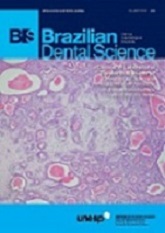Influence of adhesive system in bond strength of fiber glass posts to radicular dentin using dual cure resin cement
DOI:
https://doi.org/10.14295/bds.2014.v17i1.932Abstract
The purpose of this study was to evaluate the bond strength between root dentin and glass fiber posts cemented with dual cure resinous cement associated with the conventional and self-etching adhesive systems. Twenty-four single-rooted human teeth were selected, and the crowns were removed at the cement enamel junction. The roots received biomechanical preparation and obturation followed by the intraradicular preparation compatible with a drill diameter of the glass fiber posts. The roots were divided into two groups, according to cementation protocol (n-12): Group 1 - etched with 37% phosphoric acid for 30 seconds, total-etch adhesive system Single Bond (3M ESPE) and Enforce resinous cement (Dentsply); Group 2 – self-etch adhesive system One Up Bond F (Tokuyama) and Enforce resinous cement (Dentsply). After the posts cementation, the roots were kept at 370 C for one week, and submitted to pull out test on the universal testing machine Emic to a traction speed of 1 mm/min. Data in MPa were submitted to the statistical t-test (5%). The t-test showed significant differences between the two groups (p=0.003). The average values in MPa (±standard-deviation) were: Group 1: 5.28(±3.25), Group 2: 10.05(±3.78). Enforce associated with the self-etch adhesive system One Up Bond F showed significantly higher bond strength values than Group 1 - Enforce associated with the total-etch adhesive system Single Bond.
Downloads
Downloads
Additional Files
Published
How to Cite
Issue
Section
License
Brazilian Dental Science uses the Creative Commons (CC-BY 4.0) license, thus preserving the integrity of articles in an open access environment. The journal allows the author to retain publishing rights without restrictions.
=================




























